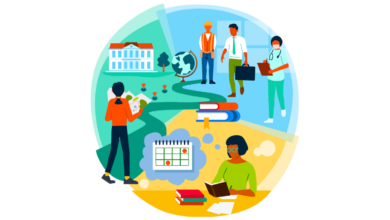The Future of Virtual Reality and Augmented Reality in Education
As technology evolves, new possibilities arise in various fields, including education. Virtual reality (VR) and augmented reality (AR) are two technologies that have the potential to revolutionize the way we learn. In this article, we’ll explore the future of VR and AR in education and the benefits they can offer to students and teachers.
Introduction
Technology has always played an important role in education, from the invention of the printing press to the introduction of computers in the classroom. Now, VR and AR are the latest technologies that have the potential to transform education. By immersing students in a simulated environment or overlaying digital information onto the real world, VR and AR can make learning more engaging, interactive, and fun.
What is Virtual Reality?
Virtual reality is a technology that uses computer-generated simulations to create a simulated environment that users can interact with. In education, VR can be used to create immersive learning experiences that allow students to explore and interact with virtual environments that are otherwise impossible or impractical to visit in real life.
Applications of VR in Education
- Simulations: VR can be used to simulate dangerous or inaccessible environments, such as space or deep sea, allowing students to learn without leaving the classroom.
- Historical recreations: VR can be used to recreate historical events or places, allowing students to experience them first-hand and gain a deeper understanding of history.
- Science experiments: VR can be used to simulate scientific experiments that are otherwise too expensive, dangerous, or complex to conduct in real life.
- Language learning: VR can be used to create immersive language learning environments that allow students to practice speaking and listening in a foreign language.
What is Augmented Reality?
Augmented reality is a technology that overlays digital information onto the real world, enhancing our perception of the environment. In education, AR can be used to enhance textbooks, posters, or other learning materials with interactive digital content.
Applications of AR in Education
- Interactive textbooks: AR can be used to add interactive content to traditional textbooks, such as 3D models, videos, or quizzes.
- Virtual field trips: AR can be used to overlay digital information onto real-world locations, allowing students to learn about the environment they are in.
- Anatomy education: AR can be used to overlay 3D models of organs or body systems onto the human body, allowing students to learn about anatomy in a more interactive way.
- STEM education: AR can be used to create interactive models of scientific phenomena, such as the solar system or the periodic table.
Benefits of VR and AR in Education
VR and AR offer several benefits that can enhance the learning experience for students and teachers alike.
- Engagement: VR and AR make learning more engaging by providing immersive and interactive experiences that capture students’ attention and imagination.
- Accessibility: VR and AR can make learning accessible to students who may not have the opportunity to experience certain environments or situations in real life.
- Personalization: VR and AR can be used to create personalized learning experiences that adapt to each student’s learning style and pace.
- Collaboration: VR and AR can facilitate collaboration and teamwork by allowing students to interact with each other in a virtual or augmented environment.
- Assessment: VR and AR can provide real-time feedback and assessment of students’ performance, allowing teachers to adjust their teaching strategies accordingly.
Challenges of VR and AR in Education
While VR and AR offer many benefits, they also present some challenges that need to be addressed.
- Cost: VR and AR technologies can be expensive, making them inaccessible to some schools or students.
- Infrastructure: VR and AR require robust and reliable infrastructure, including high-speed internet, powerful computers, and specialized software, which may not be available in all schools.
- Content creation: Creating high-quality content for VR and AR requires specialized skills and resources, which may not be available to all educators.
- Integration with curriculum: VR and AR should be integrated into the curriculum in a meaningful way to enhance learning outcomes, rather than being used as a novelty or distraction.
Future of VR and AR in Education
Despite the challenges, the future of VR and AR in education looks promising. As the technology becomes more accessible and affordable, more schools and educators are likely to adopt it. In addition, the development of new educational content and tools specifically designed for VR and AR will make it easier for educators to incorporate these technologies into their teaching.
Some possible future developments in VR and AR in education include:
- Virtual classrooms: VR can be used to create immersive virtual classrooms that allow students to interact with each other and their teacher in a simulated environment.
- Personalized learning: VR and AR can be used to create personalized learning experiences that adapt to each student’s needs and preferences.
- Career training: VR and AR can be used to provide career training in a wide range of fields, from healthcare to engineering.
- Gaming and entertainment: VR and AR can be used to create educational games and entertainment that teach students valuable skills and knowledge.




